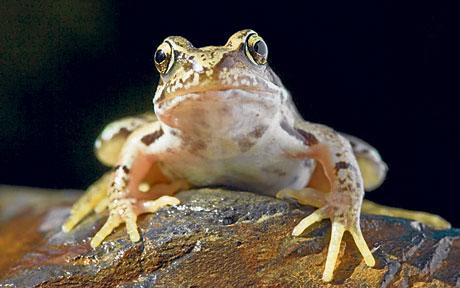
Scientists have long known that the skin of frogs contains plenty of powerful germ-fighting substances because of the hostile environments they exist in.
But the substances are also often poisonous to humans.
Now a team at the United Aran Emirates University have worked out a way of modifying the chemicals to remove their harmful side-effects.
They have already identified 100 new antibiotics including one that could fight the hospital Superbug methicillin-resistant Staphylococcus aureus (MRSA) bacteria.
Frog skin is an excellent potential source of such antibiotic agents," said Dr Michael Conlon, a biochemist at the university in Abu Dhabi.
"They've been around 300 million years, so they've had plenty of time to learn how to defend themselves against disease-causing microbes in the environment.
"Their own environment includes polluted waterways where strong defenses against pathogens are a must."
Scientists have known for years that the skin of frogs is a rich source of chemicals capable of killing bacteria, viruses, and fungi.
Researchers have attempted to isolate those germ-fighting chemicals and make them suitable for development into new antibiotics.
Success, however, has been elusive because the antibiotics tend to be toxic to human cells and certain chemicals in the bloodstream easily destroy them.
Dr Conlon and colleagues have discovered a way to tweak their molecular structure, making them less toxic to human cells but more powerful germ killers.
Similarly, the scientists also discovered other tweaks that enabled the frog skin secretions to shrug off attack by destructive enzymes in the blood.
The result was antibiotics that last longer in the bloodstream and are more likely to be effective as infection fighters, Conlon noted.
The antibiotic substances work in an unusual way that makes it very difficult for disease-causing microbes to develop resistance, Dr Conlon said.
The scientists are currently screening skin secretions from more than 6,000 species of frogs for antibiotic activity. So far, they have purified and determined the chemical structure of barely 200, leaving a potential bonanza of antibiotic substances awaiting discovery.
One substance isolated from the skin secretions of the Foothill Yellow-legged Frog - a species once common in California and Oregon but now facing extinction - shows promise for killing methicillin-resistant Staphylococcus aureus (MRSA) bacteria. MRSA is a "Superbug," infamous for causing deadly outbreaks of infection among hospitalized patients.
The skin of the mink frog, likewise, contains secretions that show promise for fighting "Iraqibacter," caused by multidrug-resistant Acinetobacter baumanni.
The findings were outlined at the American Chemical Society conference in Boston.



Reader Comments
to our Newsletter